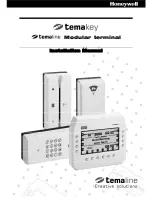
3-24
Driving the Display
PX 30 and PX 120 Operating Manual
In "text" and "variable" modes, the ID-Byte in Data (2) should be transmitted in the follow-
ing format:
7 6 5 4 3 2 1 0 Bit
A ? _ N C n n n Data (2)
A = 1
Display IBM-ASCII-coded variables
A = 0
Display binary or BCD-coded variables
? = 1
Inserts "?"; flashes alternately with the lowest value digit of the
variable value
? = 0
"?" not inserted
_ = 1
Inserts "_"; flashes alternately with the lowest value digit of the
variable value
_ = 0
"_" not inserted
If ? = 1 and _ = 1, "?" will be inserted.
"?" or "_" can still be flashed at the point of the lowest value digit even when the variable
value is not transmitted (Data (2) as Data (DL)).
N = 1
A negative prefix ("-") is placed before the variable value
N = 0
Display without negative prefix
Important: The "N" Bit is only significant when you are selecting variables in BCD-mode.
Binary-mode operates with signed integers.
C = 1
BCD-coded transmission
C = 0
Binary-coded transmission
nnn
In variable mode, variable numbers (0 ... 7) should be transmitted in
Bits 2 ... 0.
In special mode, the special function code (see Page 3-11) is selected in Data (2) in
bits 5 ... 0.
The following table shows the connection between operating mode, coding and the
contents of the data field from Data (1) to Data (DL).
Operating Mode
Data (n)
Contents
Binary-coded
Data (1)
50
H
text call-up
Data (2)
ID-Byte:
Binary xxxx0xxx (eg. 00
H
)
(x ... Bit is insignificant)
Data (3)
low Byte text number
Data (4)
high Byte text number
BCD-coded
Data (1)
50
H
text call-up
Data (2)
ID-Byte:
Binary xxxx1xxx (eg. 08
H
)
(x ... Bit is insignificant)
Data (3)
BCD-digit 10
1
, 10
0
of the text number
Data (4)
BCD-digit 10
3
, 10
2
of the text number
(Data (4) is omitted for text numbers 1 ... 99)
Artisan Technology Group - Quality Instrumentation ... Guaranteed | (888) 88-SOURCE | www.artisantg.com
















































